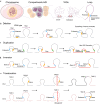Chromosome structural variation in tumorigenesis: mechanisms of formation and carcinogenesis
- PMID: 33168103
- PMCID: PMC7654176
- DOI: 10.1186/s13072-020-00371-7
Chromosome structural variation in tumorigenesis: mechanisms of formation and carcinogenesis
Abstract
With the rapid development of next-generation sequencing technology, chromosome structural variation has gradually gained increased clinical significance in tumorigenesis. However, the molecular mechanism(s) underlying this structural variation remain poorly understood. A search of the literature shows that a three-dimensional chromatin state plays a vital role in inducing structural variation and in the gene expression profiles in tumorigenesis. Structural variants may result in changes in copy number or deletions of coding sequences, as well as the perturbation of structural chromatin features, especially topological domains, and disruption of interactions between genes and their regulatory elements. This review focuses recent work aiming at elucidating how structural variations develop and misregulate oncogenes and tumor suppressors, to provide general insights into tumor formation mechanisms and to provide potential targets for future anticancer therapies.
Keywords: Cancer; Chromothripsis; Structural variation; Translocation.
Conflict of interest statement
The authors declare that there are no conflicts of interest.
Figures



Similar articles
-
Processes shaping cancer genomes - From mitotic defects to chromosomal rearrangements.DNA Repair (Amst). 2021 Nov;107:103207. doi: 10.1016/j.dnarep.2021.103207. Epub 2021 Aug 10. DNA Repair (Amst). 2021. PMID: 34425515 Review.
-
Chromothripsis-Explosion in Genetic Science.Cells. 2021 May 4;10(5):1102. doi: 10.3390/cells10051102. Cells. 2021. PMID: 34064429 Free PMC article. Review.
-
Rebuilding Chromosomes After Catastrophe: Emerging Mechanisms of Chromothripsis.Trends Cell Biol. 2017 Dec;27(12):917-930. doi: 10.1016/j.tcb.2017.08.005. Epub 2017 Sep 9. Trends Cell Biol. 2017. PMID: 28899600 Free PMC article. Review.
-
Loss of RanGAP1 drives chromosome instability and rapid tumorigenesis of osteosarcoma.Dev Cell. 2023 Feb 6;58(3):192-210.e11. doi: 10.1016/j.devcel.2022.12.012. Epub 2023 Jan 24. Dev Cell. 2023. PMID: 36696903
-
Homologous Recombination and the Formation of Complex Genomic Rearrangements.Trends Cell Biol. 2019 Feb;29(2):135-149. doi: 10.1016/j.tcb.2018.10.006. Epub 2018 Nov 26. Trends Cell Biol. 2019. PMID: 30497856 Free PMC article. Review.
Cited by
-
Full-spectral genome analysis of natural killer/T cell lymphoma highlights impacts of genome instability in driving its progression.Genome Med. 2024 Apr 2;16(1):48. doi: 10.1186/s13073-024-01324-5. Genome Med. 2024. PMID: 38566223 Free PMC article.
-
Unravelling the tumour genome: The evolutionary and clinical impacts of structural variants in tumourigenesis.J Pathol. 2022 Jul;257(4):479-493. doi: 10.1002/path.5901. Epub 2022 Apr 28. J Pathol. 2022. PMID: 35355264 Free PMC article. Review.
-
Effects of low dose and low dose rate low linear energy transfer radiation on animals - review of recent studies relevant for carcinogenesis.Int J Radiat Biol. 2021;97(6):757-768. doi: 10.1080/09553002.2020.1859155. Epub 2021 Jan 6. Int J Radiat Biol. 2021. PMID: 33289582 Free PMC article. Review.
-
Geotemporospatial and causal inferential epidemiological overview and survey of USA cannabis, cannabidiol and cannabinoid genotoxicity expressed in cancer incidence 2003-2017: part 3 - spatiotemporal, multivariable and causal inferential pathfinding and exploratory analyses of prostate and ovarian cancers.Arch Public Health. 2022 Mar 30;80(1):101. doi: 10.1186/s13690-022-00813-6. Arch Public Health. 2022. PMID: 35354499 Free PMC article.
-
Characterizing chromatin interactions of regulatory elements and nucleosome positions, using Hi-C, Micro-C, and promoter capture Micro-C.Epigenetics Chromatin. 2022 Dec 21;15(1):41. doi: 10.1186/s13072-022-00473-4. Epigenetics Chromatin. 2022. PMID: 36544209 Free PMC article.
References
Publication types
MeSH terms
Grants and funding
LinkOut - more resources
Full Text Sources

